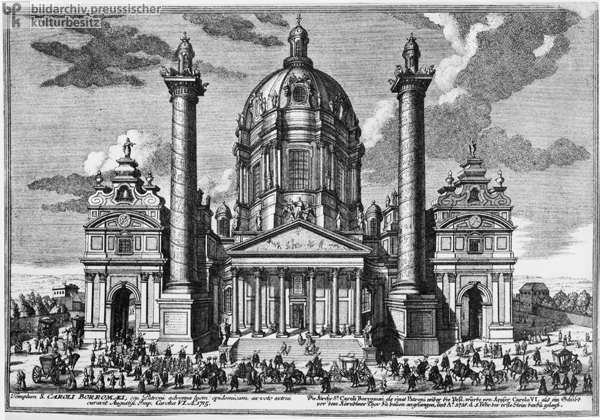













INTRODUCTION | DOCUMENTS | IMAGES | MAPS | EDITOR
|
The ambitions of absolutist rulers of the Baroque era found expression not only in secular buildings but also in sacred architecture, where religious themes mixed with secular messages in intricate ways. Built during the reign of the Habsburg Emperor Charles VI (r. 1711-1740), the Church of St. Charles in Vienna was, in the words of architectural historian S. Träger, an “affair of the state” to which all Habsburg lands were obliged to contribute financially. The church was designed by Austrian court architect Johann Bernhard Fischer von Erlach (1656-1723), whose own triumphs and fortunes were closely tied to those of the rising Habsburg empire, and whose unique architectural style – a synthesis of Italian High Baroque influences, contemporary late Baroque elements, and early Classicism – shaped Austrian taste for decades. The church owes its creation to a vow made by Charles VI during the plague epidemic of 1713. As the disease raged through the city, he vowed to build a church dedicated to St. Charles Borromeo, the patron saint of plague victims, as soon as the epidemic had passed. He made good on his promise, and work began on the church in 1716. The Church of St. Charles incorporates a variety of stylistic and iconographical references that were carefully chosen to enhance the prestige of Charles VI and the Habsburg Empire as a whole. The church portico, for example, recalls the Roman Pantheon, and thus introduces Vienna as the new Rome, the capital of a vast and powerful empire. The two monumental spiral columns that flank the portico refer to the temple of Salomon in the Old Testament and thus present Charles VI as an emperor of peace. At the same time, the columns also allude to the Pillars of Hercules on the Straits of Gibraltar and thereby symbolize the emperor’s (futile) claim to the Spanish crown. The misery of the plague is depicted in reliefs in the pediment of the portico, while scenes from the life of the St. Charles Borromeo decorate the two columns. Copperplate engraving by Hieronymus Sperling (1695-1777), 1720.
© Bildarchiv Preußischer Kulturbesitz |
 print version
print version return to image list
return to image list previous image
previous image
